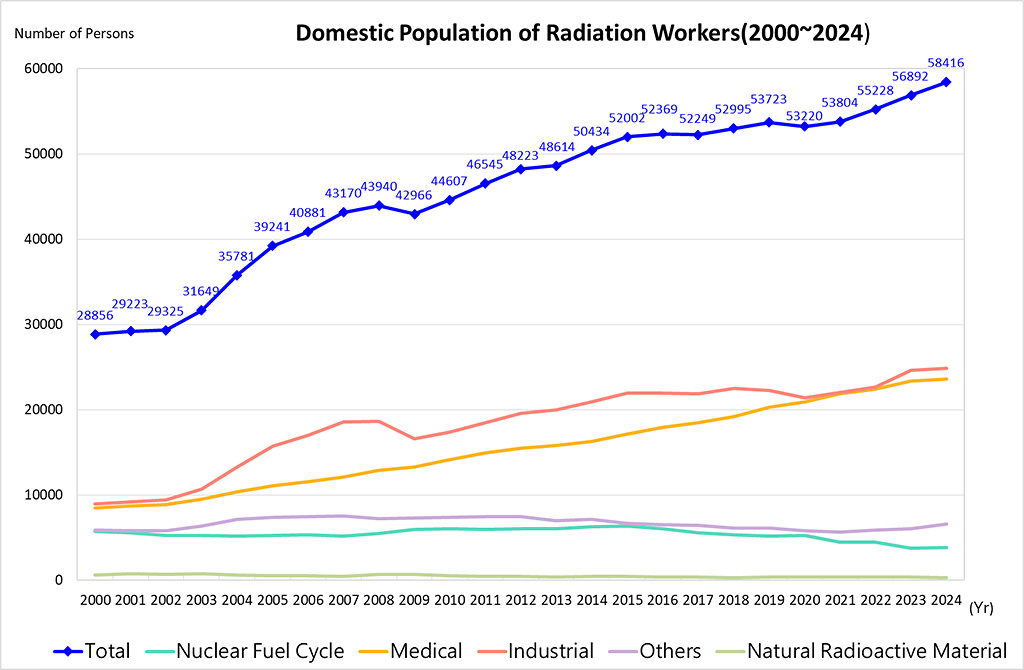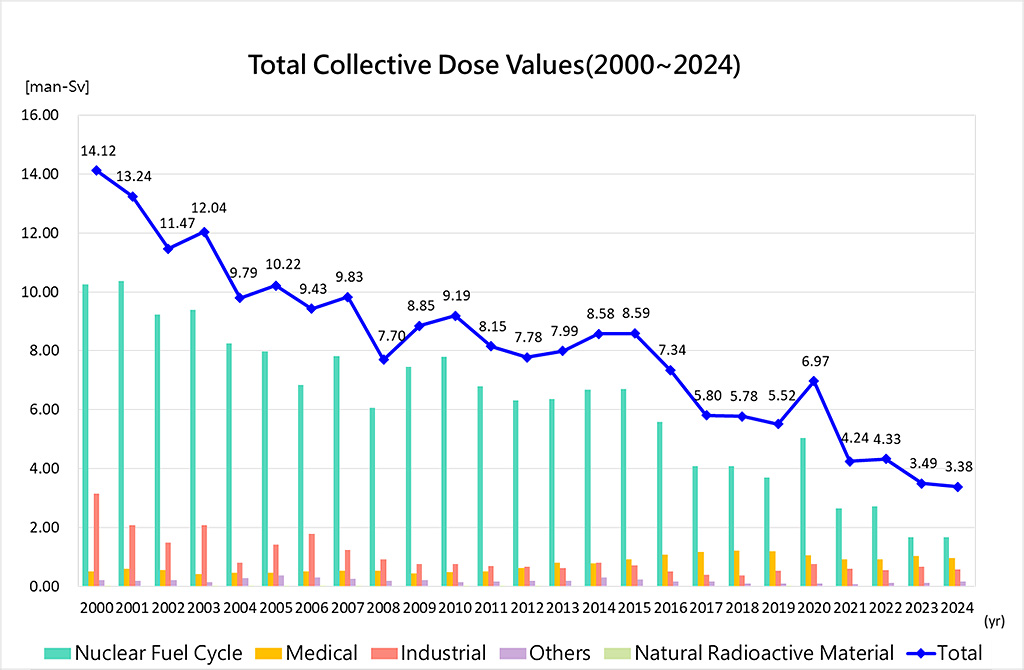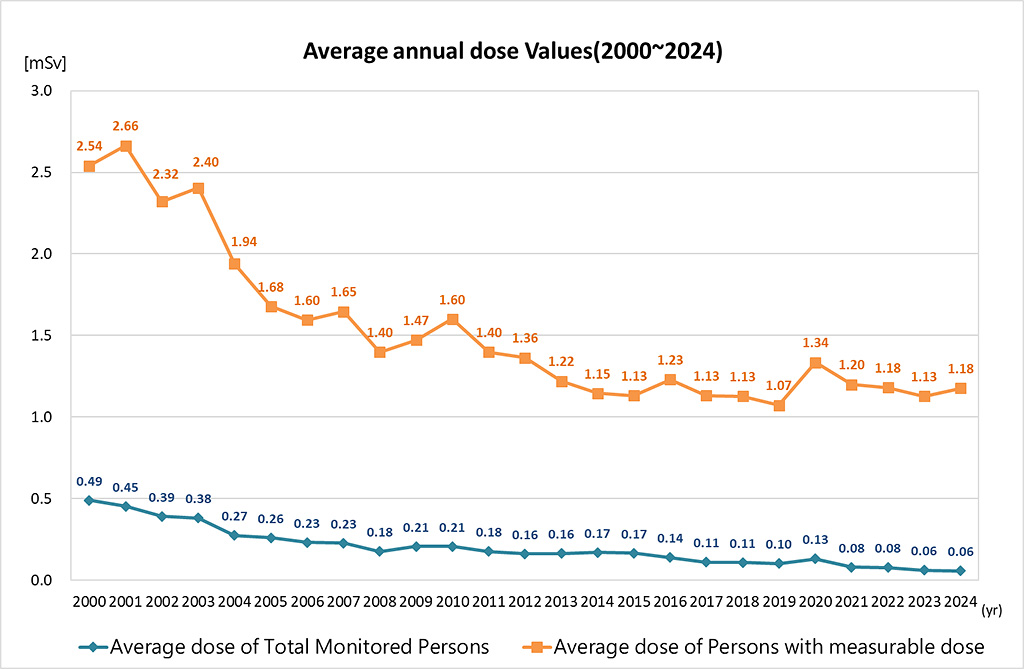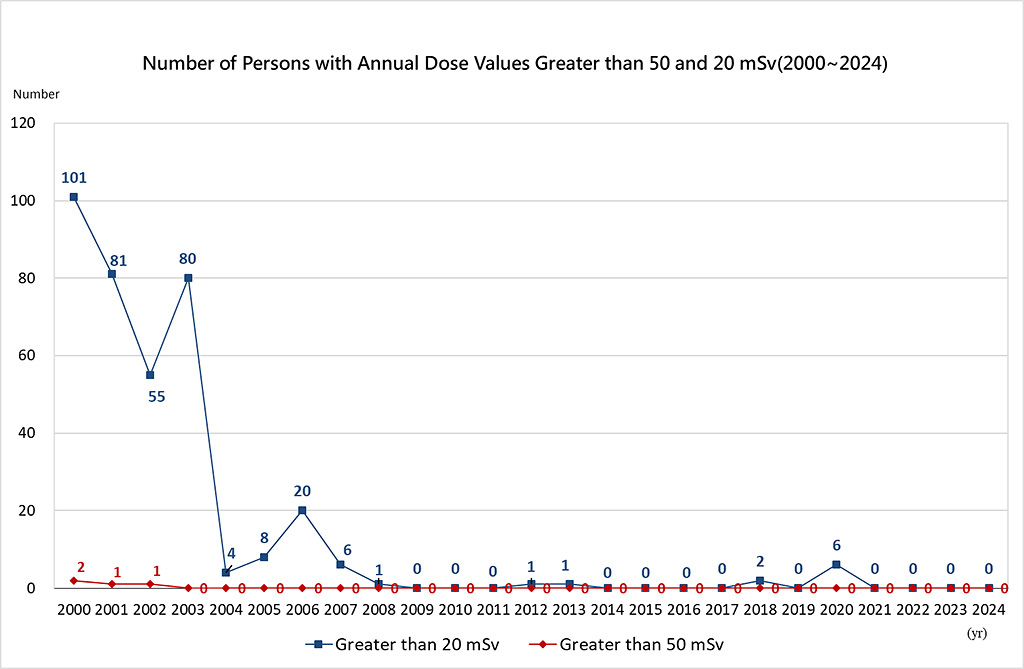:::
Statistical Report
Last Update: Jun 30, 2025
Ionizing Radiation Application and Management Statistics
2019
2020
2021
2022
2023
National Occupational Dose Management
Occupation Radiation Exposure in Taiwan, Republic of China, 2024
According to Paragraph 1 of Article 15 of Ionizing Radiation Protection Act (IRPA) : To ensure that radiation workers’ occupational exposure is below limits and kept as low as reasonably achievable, the employer shall monitor each radiation worker's dose. The Nuclear Safety Commission conducts statistical analysis of data of radiation workers every year to understand the number of radiation workers growth trend and dose distribution in Taiwan.
The annual report of NDCORE contains each working category in 2024, collects and analyzes occupational external radiation exposure data read from Thermolucent Dosimeters worn by radiation workers from 2000 to 2024 (with dosage value from neutron badges already included). Statistical results include: number of monitored persons and average dose in each dose interval, collective dose in each dose interval, number of persons in each age interval and sex group, and average monthly dose.
There were 58,416 radiation workers in Taiwan in 2024, with yearly increase from 28,856 radiation workers in 2000. The average increase rate in recent 25 years is 3.03 %. There were 1,524 persons increase, increase rate of 2.68 % from 2023 to 2024, i.e., an increase mainly from medical and industrial categories workers, as shown in Figure 1. Yearly ratio of male workers to female workers remains approximately at 66 % to 34 %.

Figure 1 Population of Radiation Workers

Figure 2 Total Collective Dose Values
Collective dose in 2024 is 3.38 man-sieverts. Domestic average annual collective dose is approximately 8.15 man-sieverts. Major dose are from nuclear fuel cycle, medical and industrial categories. Their annual collective dose occupied 49.40 %, 28.74 % and 16.95 % respectively, as shown in Figure 2. In 2024, the average dose of workers with measurable dose is 1.18 mSv, and the average dose over total radiation workers is 0.06 mSv. Average annual dose of workers with measurable dose is 1.52 mSv from 2000 to 2024. Average annual dose for total monitored persons is 0.20 mSv from 2000 to 2024, which has a downward trend, as shown in Figure 3.
According to the regulation “Safety Standards for Protection against Ionizing Radiation”(amended in 2003), the effective dose exposed by a radiation worker shall not exceed 100 mSv within a cycle of 5 years, nor 50 mSv within each year. The effective dose limit of the radiation workers was 50 mSv before 2003.
The number of radiation workers with annual dose over than 50 mSv is distributed between 0 and 2. The number of workers with annual dose exceeding 20 mSv is observed from 101 in 2000 reducing to 0 from 2021 to 2024, as shown in Figure 4.

Figure 3 Average Annual Dose Values

Figure 4 Number of Persons with Annual Dose Values Greater than 50 and 20 mSv
2019
2020
2021
2022
2023
National Occupational Dose Management
Occupation Radiation Exposure in Taiwan, Republic of China, 2024
According to Paragraph 1 of Article 15 of Ionizing Radiation Protection Act (IRPA) : To ensure that radiation workers’ occupational exposure is below limits and kept as low as reasonably achievable, the employer shall monitor each radiation worker's dose. The Nuclear Safety Commission conducts statistical analysis of data of radiation workers every year to understand the number of radiation workers growth trend and dose distribution in Taiwan.
The annual report of NDCORE contains each working category in 2024, collects and analyzes occupational external radiation exposure data read from Thermolucent Dosimeters worn by radiation workers from 2000 to 2024 (with dosage value from neutron badges already included). Statistical results include: number of monitored persons and average dose in each dose interval, collective dose in each dose interval, number of persons in each age interval and sex group, and average monthly dose.
There were 58,416 radiation workers in Taiwan in 2024, with yearly increase from 28,856 radiation workers in 2000. The average increase rate in recent 25 years is 3.03 %. There were 1,524 persons increase, increase rate of 2.68 % from 2023 to 2024, i.e., an increase mainly from medical and industrial categories workers, as shown in Figure 1. Yearly ratio of male workers to female workers remains approximately at 66 % to 34 %.

Figure 1 Population of Radiation Workers

Figure 2 Total Collective Dose Values
Collective dose in 2024 is 3.38 man-sieverts. Domestic average annual collective dose is approximately 8.15 man-sieverts. Major dose are from nuclear fuel cycle, medical and industrial categories. Their annual collective dose occupied 49.40 %, 28.74 % and 16.95 % respectively, as shown in Figure 2. In 2024, the average dose of workers with measurable dose is 1.18 mSv, and the average dose over total radiation workers is 0.06 mSv. Average annual dose of workers with measurable dose is 1.52 mSv from 2000 to 2024. Average annual dose for total monitored persons is 0.20 mSv from 2000 to 2024, which has a downward trend, as shown in Figure 3.
According to the regulation “Safety Standards for Protection against Ionizing Radiation”(amended in 2003), the effective dose exposed by a radiation worker shall not exceed 100 mSv within a cycle of 5 years, nor 50 mSv within each year. The effective dose limit of the radiation workers was 50 mSv before 2003.
The number of radiation workers with annual dose over than 50 mSv is distributed between 0 and 2. The number of workers with annual dose exceeding 20 mSv is observed from 101 in 2000 reducing to 0 from 2021 to 2024, as shown in Figure 4.

Figure 3 Average Annual Dose Values

Figure 4 Number of Persons with Annual Dose Values Greater than 50 and 20 mSv
